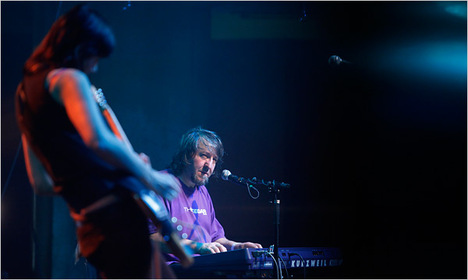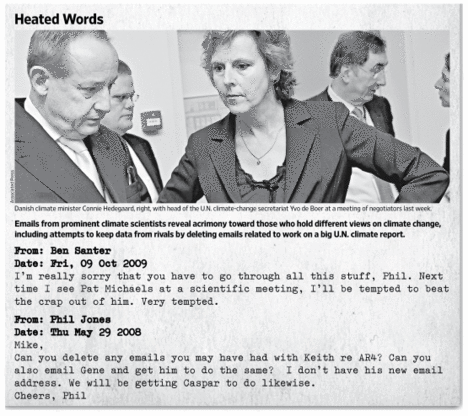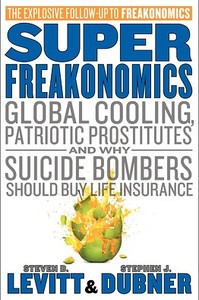(p. A1) Just two years ago, a United Nations panel that synthesizes the work of hundreds of climatologists around the world called the evidence for global warming “unequivocal.”
But as representatives of about 200 nations converge in Copenhagen on Monday to begin talks on a new international climate accord, they do so against a background of renewed attacks on the basic science of climate change.
The debate, set off by the circulation of several thousand files and e-mail messages stolen from one of the world’s foremost climate research institutes, has led some who oppose limits on greenhouse gas emissions, and at least one influential country, Saudi Arabia, to question the scientific basis for the Copenhagen talks.
The uproar has threatened to complicate a multiyear diplomatic effort already ensnared in difficult political, technical and financial disputes that have caused leaders to abandon hopes of hammering out a binding international climate treaty this year.
. . .
(p. A8) On dozens of Web sites and blogs, skeptics and foes of greenhouse gas restrictions take daily aim at the scientific arguments for human-driven climate change. The stolen material was quickly seized upon for the questions it raised about the accessibility of raw data to outsiders and whether some data had been manipulated.
An investigation into the stolen files is being conducted by the University of East Anglia, in England, where the computer breach occurred. Rajendra K. Pachauri, chairman of the United Nations Intergovernmental Panel on Climate Change, has also said he will look into the matter. At the same time, polls in the United States and Britain suggest that the number of people who doubt that global warming is dangerous or caused by humans has grown in recent years.
. . .
Science is about probability, not certainty. And the persisting uncertainties in climate science leave room for argument. What is a realistic estimate of how much temperatures will rise? How severe will the effects be? Are there tipping points beyond which the changes are uncontrollable?
Even climate scientists disagree on many of these questions. But skeptics have been critical of the data assembled to show that warming is occurring and the analytic methods that climate scientists use, including mathematical models used to demonstrate a human cause for warming and project future trends.
Both sides also have at times been criticized for overstatement in characterizing the scientific evidence. The contents of the stolen e-mail messages and documents have given fresh ammunition to the skeptics’ camp.
The Climatic Research Unit’s role as a central aggregator of temperature and other climate data has also made it a target. One widely discussed file extracted from the unit’s computers, presumed to be the log of a researcher named Ian Harris, recorded his years of frustration in trying to make sense of disparate data and described procedures — or “fudge factors,” as he called them — used by scientists to eliminate known sources of error.
For the full story, see:
ANDREW C. REVKIN and JOHN M. BRODER. “Facing Skeptics, Climate Experts Sure of Peril.” The New York Times (Mon., December 7, 2009): A1 & A8.
(Note: the online version of the article is dated Sun., December 6, 2009 and has the title “In Face of Skeptics, Experts Affirm Climate Peril.”)
(Note: ellipses added.)
Note: the online version of the article includes the following, very interesting, correction of the print version:
Correction: December 15, 2009
Because of an editing error, an article on Dec. 7 about the scientific evidence supporting global warming overstated the level of certainty expressed in a 2007 report by the Intergovernmental Panel on Climate Change, a network of scientists, that human-caused warming was under way and, if unabated, would pose rising risks. The panel said that most warming since 1950 was “very likely” caused by humans, not that there was “no doubt.” The article also misidentified the temperature data cited by a scientist at the University of East Anglia’s Climatic Research Unit who had expressed frustration in a log about trying to make sense of disparate data. The data was direct measurements of temperature, not indirect indicators like the study of tree rings.
(Note: italics and bold in original.)





